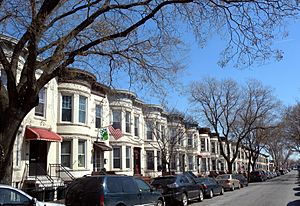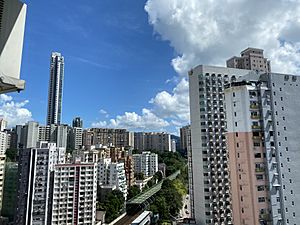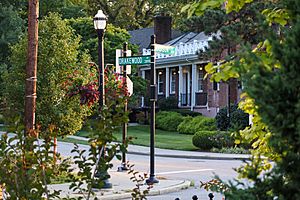Residential area facts for kids
A residential area is a place where most of the land is used for homes. This is different from areas used for factories (industrial) or shops (commercial).
Homes in residential areas can be very different. They might be houses for one family, apartments, or even mobile homes. Rules called zoning laws decide what can be built in a residential area. These rules might allow some small shops or offices, or they might only allow homes. Zoning also controls how many homes can be built in one spot. Usually, residential areas have less building space allowed compared to business or industrial areas.
Contents
What is a Residential Area?
In some residential areas, especially in the countryside, there might not be any shops or services nearby. This means people need a car or other transport to get what they need. Because of this, new neighborhoods often grow along existing roads or train lines.
Rules for how land is developed can also come from special agreements called restrictive covenants. These are like promises written into the property's deed (the ownership document). They can be hard to change because everyone who owns property in that area usually has to agree.
How Neighborhoods Are Planned


Residential development is when land is prepared and built on for homes. Sometimes, a large piece of land is divided into smaller plots, and houses are built on each one. This is often called a subdivision. These became popular in the late 1800s, especially as streetcar suburbs grew around cities.
A Look Back: How Homes Were Built
In the past, building homes was different. Wealthy people would buy land in a town and hire someone to design and build a custom house or mansion for their family. Poorer people in cities often lived in simple shantytowns or in tenement buildings, which were apartments built for rent. It was rare for single-family houses to be built just to be sold later to anyone who wanted to buy them.
But as cities grew and more people became part of the middle class, and as mortgage loans (money borrowed to buy a home) became common, building homes to sell became a popular way to meet the demand for home ownership.
The Rise of Modern Neighborhoods
After World War II, big cities in the United States, like New York City and Los Angeles, needed thousands of new homes. Companies started building many homes at once, often on large farms or ranches. They handled everything from getting permits to building streets, utilities, and the houses themselves.
Places like Levittown, Long Island saw new homes sell incredibly fast. Many ideas that made cars affordable also made houses affordable: using standard designs, breaking down building into small, repeated tasks, advertising, and easy access to money. Building many homes at once led to similar-looking houses but offered a more comfortable lifestyle than crowded city apartments. With government help for mortgages, it could even be cheaper to own a house in a new development than to rent.
Over time, these developments kept getting better. They added curving streets, parks, community pools, and special entrances. Houses started having different layouts and different outside looks, even if the basic plan was the same. Developers competed by offering good locations, community features, and different kitchen appliances.
Today, a typical residential development might have features to slow down traffic, like winding streets or dead-end roads. Some developments are gated communities or special residential communities with their own rules.
Challenges in Residential Areas
Sometimes, residential developments face criticism:
Why Some Neighborhoods Feel Isolated
- Some neighborhoods feel cut off from the rest of the community. They might have only one entrance, making it hard to get around or connect with other areas.
- Many developments are mostly for homes, meaning people have to leave the neighborhood for shops or other activities. This is different from mixed-use developments, which have homes, shops, and other services all in one place.
- If streets are not well-connected, getting around can take a long time. This also makes it harder for people to walk or cycle.
Making Neighborhoods Better
- Front yards with low walls are often well-cared for. People tend to look after their gardens and sometimes try to make them look better than their neighbors'. But some builders remove these small but important differences between public and private spaces. This can lead to areas that are not used or liked.
- Modern streets can be full of parked cars. This can look messy, block sidewalks, and make streets less safe for children. It can also cause arguments between neighbors.
- Everyone loves streets lined with trees, but new developments often don't have them. Sometimes, road authorities discourage trees and hedges. This means many new developments can look plain and lack greenery.
See also
 In Spanish: Urbanización para niños
In Spanish: Urbanización para niños




